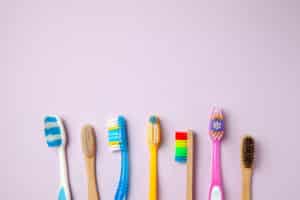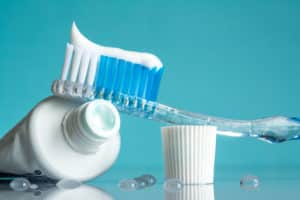10 Facts About Your Toothbrush


You use it twice a day to keep your teeth healthy and cavity-free, but how much do you really know about your toothbrush? Some of the facts may surprise you!
Are You Doing Enough?
How often do you brush your teeth? Once a day? Twice a day? Once a week? If you have established rules for brushing your teeth, it may seem like second nature to keep those pearly whites clean. It’s not so with everyone. In fact, the New York Post reported that when it comes to certain age groups (like millennials), studies found that only 3 in 10 brush their teeth once a day. Some go several days without a good teeth cleaning. 22% of that age group also avoid going to the dentist, with 6 in 10 Americans as a whole being afraid to visit the dentist.
Dental visits, brushing your teeth, flossing, having a good toothbrush and more are all essential habits to avoid oral health diseases. Those types of diseases are actually the most common ones that people get on a worldwide scale, and many don’t realize it! The lack of oral hygiene knowledge and daily habits is one reason why 64.7 million American adults have gum disease, and why tooth decay affects more than 92% of people. You can help yourself avoid these issues by learning just how important simple habits—like brushing your teeth—are for your oral health.
The ADA Seal of Acceptance
This is the gold standard for toothbrush quality, and is something you want to look for on every oral health product you buy. If a product has the “ADA Seal of Acceptance”, it means that it abides by strict rules of quality to help reduce your risk for oral health problems. With this seal, you can know the product has been tested and proven effective for combating decay-causing bacteria. These products must also contain fluoride, which is a natural mineral that helps provide a barrier between bacteria and your teeth.

Toothbrush History and The First Toothbrush
Some sources have found that people used toothbrushes as far back as 5,000 B.C., with their use being common in 3,000 B.C. by the Ancient Egyptians. Over millennia, the types of devices used to clean the teeth eventually morphed into the toothbrush we know and love today. However, that wasn’t until just a few hundred years ago.
The first mass-produced toothbrush was invented in prison by an inmate named William Addis in 1770 that was imprisoned for causing a riot. He observed how other inmates cleaned their teeth with cloth and other items. After some experiments, he created a tooth-brushing device out of an animal bone saved from dinner. He later inserted bristles, thus creating the first idea of a toothbrush. He later got out of prison and started his own toothbrush company that now manufactures over 70 million toothbrushes a year!
Manual or Electric?
Many studies have found that there isn’t a clear winner when it comes to the type of toothbrush you buy. For those who may tire easily with brushing, electric may be the better choice. However, what studies have found is that it’s more important to simply brush your teeth, period! Electric brushes do have an added advantage of helping to break up food and plaque on the teeth, but you can make up for that with thorough manual brushing.

4 Minutes a Day
The American Dental Association has found that 4 minutes of toothbrushing a day has been found to be incredibly effective at limiting your risk for tooth decay, gum disease and oral disease. They recommend to brush your teeth twice a day, for at least 2 minutes at a time. Brush in circular motions and in all different directions as you move along your teeth. Especially get along the gum line of your teeth where food and plaque are more likely to collect.
Brushing and Flossing
Even if you were taught a specific way to brush and floss your teeth, there is no perfect way to use floss or a toothbrush, nor is there an order to it. The point is to simply do both habits, in whatever order, twice a day! Do what works for you. But remember, the American Dental Association recommends that you brush your teeth with a quality toothbrush for 2 minutes at a time, at least twice a day. Pick a method that works for you and helps you to prevent cavities.
Choose Soft Bristles
Next time you go to the store, notice how every toothbrush will say, “hard”, “medium”, or “soft”. Softer bristles are generally better for your teeth, as harder bristles (more rigid ones) can actually take layers of your tooth enamel off. Ask your dentist, as your specific oral situation (like tarter buildup) may necessitate a harder brush.

Toothbrushes Prefer Open Air and a Short Life
The ADA’s recommendation for maximum toothbrush use is 3 months due to bacteria buildup. You may need to discard your toothbrush sooner if the bristles have become frayed, as it cleans less effectively. Dry your toothbrush after use and store it in a clean container that is somewhat open to the air so it fully dries. If not, more bacteria could grow.
Don’t Share Your Toothbrush!
Typically, sharing a toothbrush is not a good idea. Sharing a toothbrush with your significant other can transfer bacteria that causes illness in yourself, even if the other person doesn’t show signs of sickness. Detected mouth bacteria in studies has found bacteria numbering in the 700s—yikes! The average mouth has between 32 and 80 different types of bacteria. Sharing is not caring in all situations!
Get A Quality Toothbrush Today
Find a quality toothbrush, toothpaste, and other oral health products, and follow the recommended guidelines for use if you want to avoid oral health diseases. To find out what products we recommend, call Dr. Ania’s office today at 303-443-0998!


